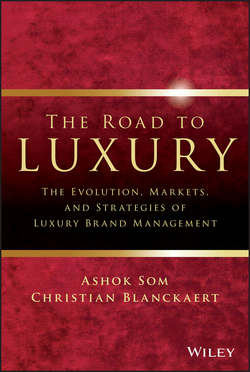Читать книгу The Road To Luxury - Blanckaert Christian - Страница 20
На сайте Литреса книга снята с продажи.
Chapter 3
Who's Who of Luxury
ОглавлениеThe top six players in the luxury industry – LVMH, Richemont, Kering, Swatch, Tiffany, and Hermès – account for 30 percent of the industry turnover.
Moreover, luxury goods have traditionally been associated with France and Italy, with Italy producing one third of all of the world's luxury goods, making it the largest luxury-goods-producing nation. Italy was the birthplace of famous brands such as Armani, Moncler, Prada, Zegna, and Ferragamo, to name just a few.
The multibrand conglomerates with revenues in excess of US$1 billion are LVMH, Richemont, Kering, Swatch, Hermès, and L'Oréal.
Similarly, there exist star monobrand companies with revenues in excess of US$1 billion, for example, Burberry, Chanel, Tiffany, Armani, Ralph Lauren, and others. While many of these companies operate under only one brand name, they compete in a variety of product sectors. Table 3.1 gives the details of the mono- and multibrands.
Table 3.1 Leaders in the Multibrand and Monobrand Luxury Sector
The Consumers
By 2005, luxury goods were no longer exclusive to high-net-worth individuals. Worldwide, 7.7 million people have the purchasing power to buy prestigious goods for themselves. Globally, women represent the largest purchasers of luxury goods; they account for 80 percent of cosmetics and 70 percent of fashion. The consumer profile is evolving. Men also are spending on luxury products that portray quality, service, prestige, and gracious style. The brands have given birth to a need that does not exist and created an image that can seduce. Middle-class consumers are increasingly seeking quality and designer clothes. For example, recent trends show luxury consumers are purchasing one Brioni suit for $3,000 rather than three ordinary suits at $1,000 each. These consumers are both quality- and price-conscious and weigh their options on pleasure and aesthetic.
The last few years have witnessed a shift from the traditional affluent target consumers to a broader and younger audience. This phenomenon was driven by the conspicuous consumption movement, influenced by celebrities' endorsements of luxury goods. This meant that younger consumers were accessing the luxury market by purchasing small price-point items like caps and key rings. Luxury goods companies were only too happy to oblige via downward extensions, making their brands accessible to consumers who could not otherwise afford to purchase a luxury product. For example, Tiffany sold silver bangles and Louis Vuitton produced cheaper synthetic versions of its super-expensive leather and crocodile-skin bags. Currently, low-ticket items comprise approximately 55 percent of all luxury sales.
Конец ознакомительного фрагмента. Купить книгу
